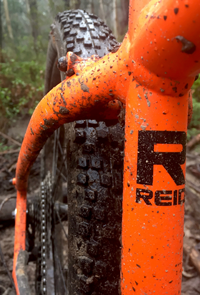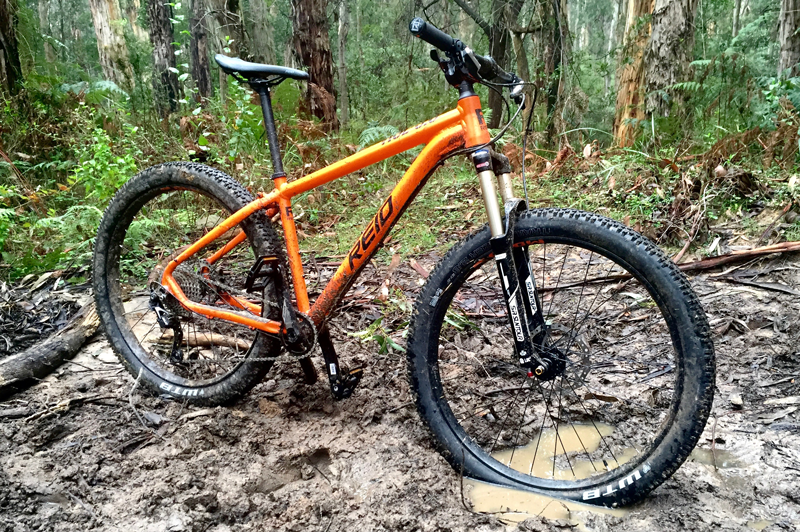Euan Pennington puts a budget-friendly fun machine to the test.
 Plus bikes are the latest in off-road cycling developments, offering wider rims and bigger tyres than a standard mountain bike. Simplistically, they aim for the grip and capability of a fatbike (minus some of its handling quirks), coupled with the handling and agility of a mountain bike. For the novice this means more grip and forgiveness, and it can also open up new terrain for the proficient rider.
Plus bikes are the latest in off-road cycling developments, offering wider rims and bigger tyres than a standard mountain bike. Simplistically, they aim for the grip and capability of a fatbike (minus some of its handling quirks), coupled with the handling and agility of a mountain bike. For the novice this means more grip and forgiveness, and it can also open up new terrain for the proficient rider.
Reid Cycles have recently released the Vice range, their first foray into the realm of plus bikes. With three models in the range the 3.0, tested here, is their flagship machine. Out of the box it presents well, and is certainly orange. The fork is a 120mm offering from Suntour, and all the current frame standards are addressed – tubeless-ready wheels, tapered headset, thru axles front and rear. In a rapidly changing retail environment, this frame is as future proofed as possible. There are two bottle mounts, and the cables are routed externally, making field service easy.
Braking and shifting are handled by the lower end of Shimano’s off-road range; lower end yes, losing some of the adjustability and carbon fibre of higher models, but none of Shimano’s industrial strength function and reliability. Reid appears to have done a good job of giving you performance where it matters. Worthy braking and shifting, and the seat, pedals and grips are comfortable contact points.
 The rims are 40mm wide and the tyres 2.8 inch, so the Vice rests at the narrower end of the plus bike spectrum. WTB were one of the first tyre manufacturers to leap into the plus bike pool, and they have produced a sound offering. The tread on these Trail Blazers is close packed, so rolls fast, and the sheer area of rubber on the track means there is a metric shed-load of grip, an advantage heading both up and down.
The rims are 40mm wide and the tyres 2.8 inch, so the Vice rests at the narrower end of the plus bike spectrum. WTB were one of the first tyre manufacturers to leap into the plus bike pool, and they have produced a sound offering. The tread on these Trail Blazers is close packed, so rolls fast, and the sheer area of rubber on the track means there is a metric shed-load of grip, an advantage heading both up and down.
Body position on the bike is reasonably upright, weight is central and the rig moves quickly on hard surfaces. Hitting the dirt and the bike climbs well without the front wandering too much, although the starting weight of 14kg can be noticed. The 1×10 gearing provides enough range for general use, and trades a cog or two for simplicity and reduced maintenance. As befits an off-road bike, the gearing is low, so some gears are lost at the top end. Like a LandCruiser, you might not get there fast, but nothing will stop your arrival.
Descending on this bike is something that won’t disappoint. The neutral body position makes it easy to move around the cockpit for maximum control. The Suntour fork lacks some of the finesse of its more costly competition, but still cushions the bumps, and that – coupled with high-calibre brakes and aforementioned grip from the big rubber, plus wide bars and a shortish stem – means the rider is enabled to travel at speeds that may not always be wise. The handling is predictable, delivering no consternation at stressful junctures, which is ideal for beginner and expert alike.
The burly alloy frame delivered an unsurprisingly harsh ride until the tyres were converted to a tubeless set-up, which they are ready for straight out of the box; with 10 to 15psi of air in each end and a total of 800 grams of inner tube removed, this bike became a very different animal. Don’t waste time on this decision – as the T-shirt says, just do it.
If you were to close your eyes as you frolicked about on the Vice, apart from having a ghastly accident, you could be forgiven for thinking you were on a more expensive steed. It is smooth, handles well and the key componentry is of good quality, delivering a better than expected ride.
Plus bikes are relatively new to the market, and currently both consumers and manufacturers are still not sure where they are going. Within all this Reid have created a Swiss Army knife. It handles well off-road, is comfortable on-road, and has the mounts for a rack should you wish to do a little light touring or rail trail exploration. It has a simplicity that is appealing – no front derailleur, no rear suspension, yet still capable in the dirt. Yes, the fork is a little agricultural, and the gear range is not as wide as it could be, but if you want more you have to pay more. Alternatively, the lower-end Vice 2.0 drops the suspension fork in favor of a rigid fork, and with a couple of other minor tweaks also sheds $400 from the price.
The Vice 3.0 retails for $1399, which is good value considering how it rides – it’s a highly versatile machine for dirt and beyond. Reid has traditionally been a “budget” brand, but this represents for them an in-road into new territory: still good value, but better quality.
For more info or to buy, reidcycles.com.au
Photography Euan Pennington
Ride On content is editorially independent, but is supported financially by members of Bicycle Network. If you enjoy our articles and want to support the future publication of high-quality content, please consider helping out by becoming a member.

